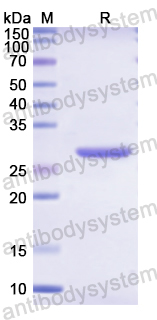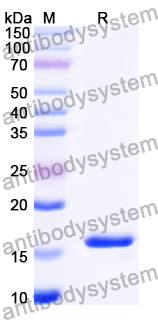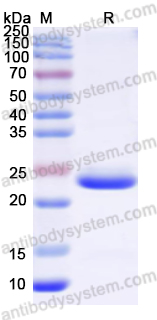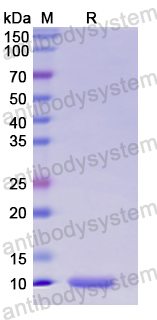Catalog No.
YHC17401
Expression system
E. coli
Species
Homo sapiens (Human)
Protein length
Asp276-Ser499
Predicted molecular weight
28.01 kDa
Nature
Recombinant
Endotoxin level
Please contact with the lab for this information.
Purity
>90% as determined by SDS-PAGE.
Accession
P05546
Applications
ELISA, Immunogen, SDS-PAGE, WB, Bioactivity testing in progress
Form
Lyophilized
Storage buffer
Lyophilized from a solution in PBS pH 7.4, 0.02% NLS, 1mM EDTA, 4% Trehalose, 1% Mannitol.
Reconstitution
Reconstitute in sterile water for a stock solution. A copy of datasheet will be provided with the products, please refer to it for details.
Shipping
In general, proteins are provided as lyophilized powder/frozen liquid. They are shipped out with dry ice/blue ice unless customers require otherwise.
Stability and Storage
Use a manual defrost freezer and avoid repeated freeze thaw cycles. Store at 2 to 8°C for frequent use. Store at -20 to -80°C for twelve months from the date of receipt.
Alternative Names
SERPIND1, HC-II, Heparin cofactor 2, HLS2, Protease inhibitor leuserpin-2, Serpin D1, Heparin cofactor II, HCF2
TMT-based quantitative proteomics analysis of serum-derived exosomes in patients with juvenile gout., PMID:40444241
Unveiling the levels and significance of different serpin family proteins in aqueous humor dynamics., PMID:40389884
4D label-free quantitative proteomic and phosphoproteomic profiling of the kidney in rat models of antimyeloperoxidase-associated vasculitis., PMID:40201969
Proteomics Analysis of Five Potential Plasma-derived Exosomal Biomarkers for Acute Myocardial Infarction., PMID:39754756
Insights into Medication-Induced Osteonecrosis of the Jaw Through the Application of Salivary Proteomics and Bioinformatics., PMID:39596473
Proteomic and metabolomic profiles of plasma-derived Extracellular Vesicles differentiate melanoma patients from healthy controls., PMID:39405606
Discovery of candidate biomarkers from plasma-derived extracellular vesicles of patients with cirrhosis and hepatocellular carcinoma: an exploratory proteomic study., PMID:39011654
Identification of Differentially Expressed mRNAs and lncRNAs Contributes to Elucidation of Underlying Pathogenesis and Therapeutic Strategy of Recurrent Implantation Failure., PMID:38955937
The genetic risk factors for cerebral venous thrombosis: a case-control study in a Chinese national comprehensive hospital., PMID:38886735
A reduced proteomic signature in critically ill Covid-19 patients determined with plasma antibody micro-array and machine learning., PMID:38760690
Secreted proteins in plasma and placenta as novel non-invasive biomarkers for intrahepatic cholestasis of pregnancy: A case-control study., PMID:38027820
Proteomic biomarkers for survival in systemic sclerosis-associated pulmonary hypertension., PMID:37936223
Differential analysis of core-fucosylated glycoproteomics enabled by single-step truncation of N-glycans., PMID:37542637
A Systematic Investigation of Complement and Coagulation-Related Protein in Autism Spectrum Disorder Using Multiple Reaction Monitoring Technology., PMID:37031449
Identification of the Level of Exosomal Protein by Parallel Reaction Monitoring Technology in HCC Patients., PMID:36267426
Oncogenic Mutation BRAF V600E Changes Phenotypic Behavior of THLE-2 Liver Cells through Alteration of Gene Expression., PMID:35163468
Predicting Radioresistant Biomarkers in Nasopharyngeal Carcinoma Patients Via Protein-Protein Interaction Network Analysis., PMID:35155161
Differential proteomic analysis demonstrates follicle fluid participate immune reaction and protein translation in yak., PMID:35031034
Platelets' RNA as biomarker trove for differentiation of early-stage hepatocellular carcinoma from underlying cirrhotic nodules., PMID:34469466
Polycyclic aromatic hydrocarbons induce endothelial injury through miR-155 to promote atherosclerosis., PMID:34331478
Bioinformatic Analysis of the Proteome in Exosomes Derived From Plasma: Exosomes Involved in Cholesterol Metabolism Process of Patients With Spinal Cord Injury in the Acute Phase., PMID:34305563
Proteome Characterization of Glaucoma Aqueous Humor., PMID:34214668
Plasma heparin cofactor II activity is inversely associated with albuminuria and its annual deterioration in patients with diabetes., PMID:34043882
Targeted next-generation sequencing reveals novel and known variants of thrombophilia associated genes in Saudi patients with venous thromboembolism., PMID:34015304
Identification and characterization of a novel isoform of heparin cofactor II in human liver., PMID:32827448
SERPIND1 Affects the Malignant Biological Behavior of Epithelial Ovarian Cancer via the PI3K/AKT Pathway: A Mechanistic Study., PMID:31637210
Five Hub Genes Can Be The Potential DNA Methylation Biomarkers For Cholangiocarcinoma Using Bioinformatics Analysis., PMID:31632083
Influence of metabolic status and genetic merit for fertility on proteomic composition of bovine oviduct fluid†., PMID:31347661
Serum proteomics identify potential biomarkers for nasopharyngeal carcinoma sensitivity to radiotherapy., PMID:31040200
An analysis of plasma reveals proteins in the acute phase response pathway to be candidate diagnostic biomarkers for depression., PMID:30611956
Protein expression in the liver and blood serum in chickens in response to Salmonella Enteritidis infection., PMID:30458997
Cloning of six serpin genes and their responses to GCRV infection in grass carp (Ctenopharyngodon idella)., PMID:30439497
Modulating the degree of fucosylation of fucosylated chondroitin sulfate enhances heparin cofactor II-dependent thrombin inhibition., PMID:29787913
Alpha-2-macroglobulin and heparin cofactor II and the vulnerability of carotid atherosclerotic plaques: An iTRAQ-based analysis., PMID:28087279
Analysis of the gene expression profile in response to human epididymis protein 4 in epithelial ovarian cancer cells., PMID:27430660
Proteome Profile and Quantitative Proteomic Analysis of Buffalo (Bubalusbubalis) Follicular Fluid during Follicle Development., PMID:27136540
Loss of Biglycan Enhances Thrombin Generation in Apolipoprotein E-Deficient Mice: Implications for Inflammation and Atherosclerosis., PMID:27034473
A panel of glycoproteins as candidate biomarkers for early diagnosis and treatment evaluation of B-cell acute lymphoblastic leukemia., PMID:26823978
Investigation into the effects of antioxidant-rich extract of Tamarindus indica leaf on antioxidant enzyme activities, oxidative stress and gene expression profiles in HepG2 cells., PMID:26557426
Bayesian phylogeny analysis of vertebrate serpins illustrates evolutionary conservation of the intron and indels based six groups classification system from lampreys for ∼500 MY., PMID:26157611
Structural analysis and anticoagulant activities of the novel sulfated fucan possessing a regular well-defined repeating unit from sea cucumber., PMID:25871288
Cerebrospinal fluid proteomics in children during induction for acute lymphoblastic leukemia: A pilot study., PMID:25809122
[Plasma heparin cofactor II activity correlates with the incidence of in-stent restenosis after the intervention of arteriosclerosis obliterans in lower extremity]., PMID:25769326
Prothrombotic SERPINC1 gene polymorphism may affect heparin sensitivity among different ethnicities of Chinese patients receiving heart surgery., PMID:25361738
Heparin co-factor II enhances cell motility and promotes metastasis in non-small cell lung cancer., PMID:25130770
Genetic variants and evolutionary analyses of heparin cofactor II., PMID:24950623
Effects of PEGylation on membrane and lipopolysaccharide interactions of host defense peptides., PMID:24588750
The collection of NFATc1-dependent transcripts in the osteoclast includes numerous genes non-essential to physiologic bone resorption., PMID:22985540
Heparin cofactor II, a serine protease inhibitor, promotes angiogenesis via activation of the AMP-activated protein kinase-endothelial nitric-oxide synthase signaling pathway., PMID:22904320
Serpin-glycosaminoglycan interactions., PMID:22078533




